ESSAYS No: XLIII | November 18, 2015 | By Viveka Hansen
One of the earlier historical essays includes some brief research of fashion and cloth trade-cards from The British Museum Collection online, dating back to the early 18th century. Once again, the aim will be to study historical events from this fascinating and very extensive collection, now based on a search for “haberdashers trade cards”, to get a better understanding of what businesses within this trade sold/offered their customers in London. Additionally, this text will focus on the handwritten notes and receipts to get an idea of what the purchasing men or women paid for their goods. A number of representative images describe this multi-faceted textile trade in various contexts.
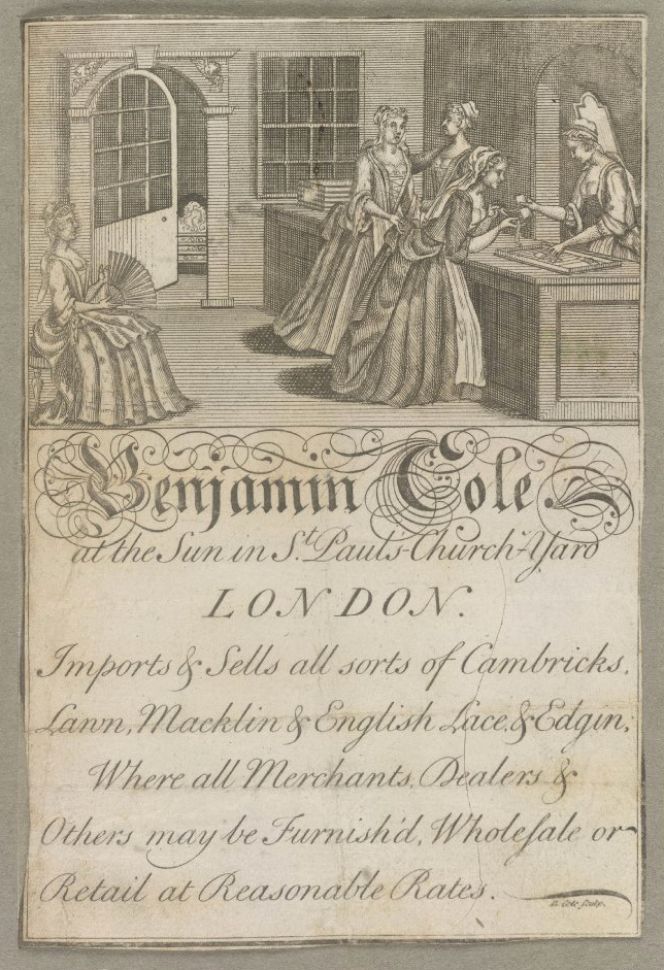
Benjamin Cole in St Paul’s Church-Yard, London – is marked as “Haberdasher” in the collection – a shop owner who sold a variety of fabrics and lace. This 18th century card is also extraordinarily rare and informative with its image of female shop assistants and customers. Courtesy of: © Trustees of the British Museum, Trade cards, Heal 70.39 (Collection online).
Sarah Sophia Banks (1744-1818) is regarded as one of the original contemporary collectors, whilst Sir Ambrose Heal (1872-1959) had a historical interest foremost in 18th century trade cards. Many thousands of cards from these two collectors are kept at the British Museum, and 212 of the cards can be linked to haberdashers. Even if this is a random selection of haberdashers working over a period of almost 75 years (c. 1745-1818), the search is large enough for a general study of various business transactions and traditions of the trade in London.
Notice: A small number of these 212 trade cards originate from other English cities/towns.
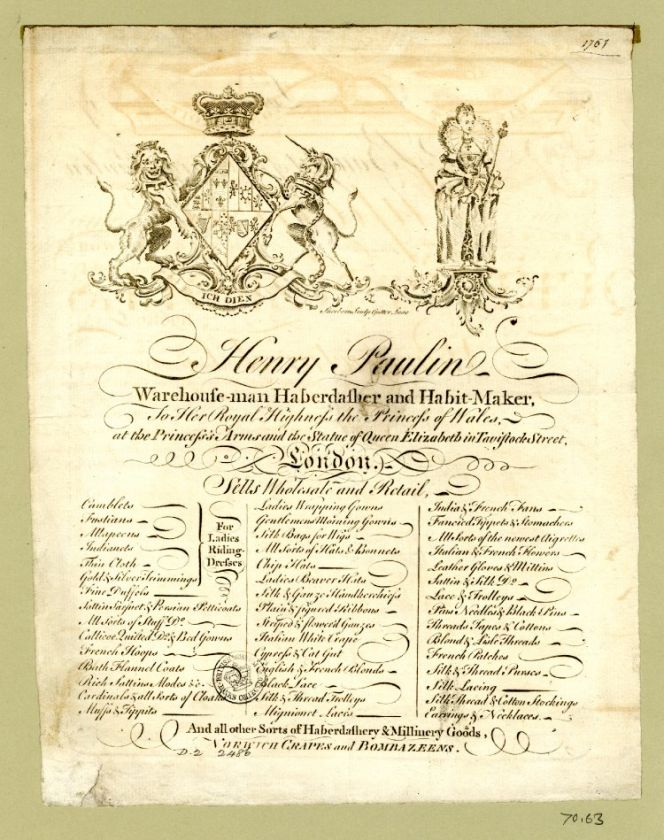
It was popular to list all sorts of haberdashery goods during the second half of the 18th century – to demonstrate the strength and possibility with a large amount of products for sale in one’s establishment. Here exemplified with Henry Paulin – Warehouse-man, Haberdasher and Habit-Maker in London, dated ‘1761’ in ink. Courtesy of: © Trustees of the British Museum, Trade cards, Banks 70.63 (Collection online).
A tradesman in this occupation was, among other matters, described as ‘One who sells small wares; a pedlar.’ by Samuel Johnson in A Dictionary of the English Language in 1755. A myriad of “small wares” is also the overall impression of the haberdasher’s trade, whilst these men and women sold all sorts of minor goods. For many a basic assortment of fabrics included qualities of wool, silk, cotton and linen – frequently described as ‘Worsted & Silks of all Sorts’. Together with laces, needles, pins, ribbons, threads, stockings, dressings, linings, patches, knittings, canvas, yarns, silk bags, muffs, hats, gloves, handkerchiefs, whale bones etc, accessories for dress and much more. Sometimes, even if fifty or more goods were listed, one can read ‘With Various other Articles, in the Haberdashery Trades, too numerous to insert in this Bill’.
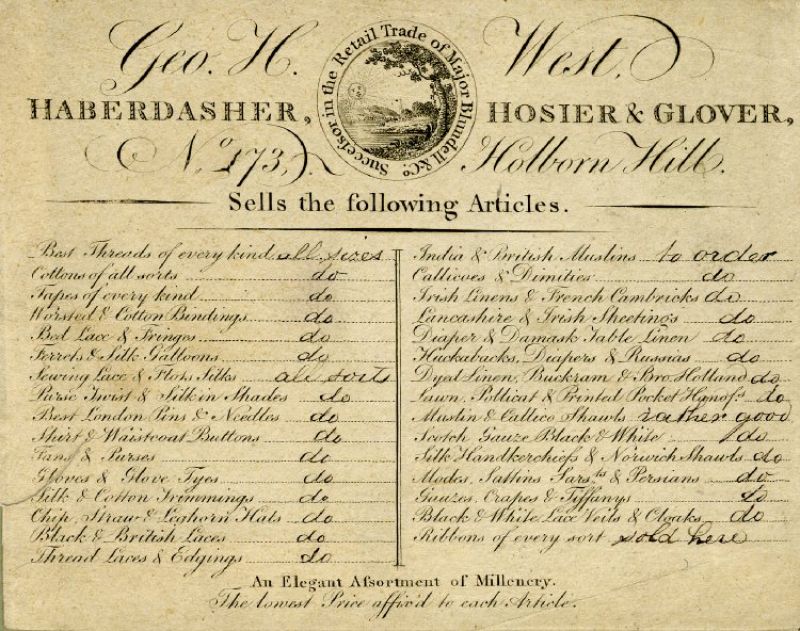
Geo. H. West – Haberdasher, Hosier & Glover of Holborn Hill in London – is one such dealer whose trade card demonstrates a wide variation of goods. The unique features of his card are the handwritten notes added to each product informing a costumer about “all sorts”, “of every kind” “rather good” and “sold here” to emphasise the richness of choice in his shop together with “to order” to further strengthen his intentions to satisfy his customers wishes. Courtesy of: © Trustees of the British Museum, Trade cards, Heal 70.185. (Collection online).
Haberdashers or the “haberdasher of small wares” were also frequently mixed with all other sorts of textile trades: Glover, milliner, hatter, hosier, lace man, lace & warehouse, pattern drawers, linen drapery, thread maker, or described as selling cloaks, child- and bed linen, children’s clothes, muslins, riding habits, masquerade dresses or furs. Together with some establishments that combined the haberdashery with selling swords & cutlery, wire making, perfumes, hair powder or cleaned and dyed feathers. While other haberdashers sold ‘all sorts of Coffee Raw or Roasted’, chocolate, snuffs, green and black teas or ‘all sorts of fine Teas’, ‘Playing Cards’ or noted ‘Books Sold or lent to Read’.
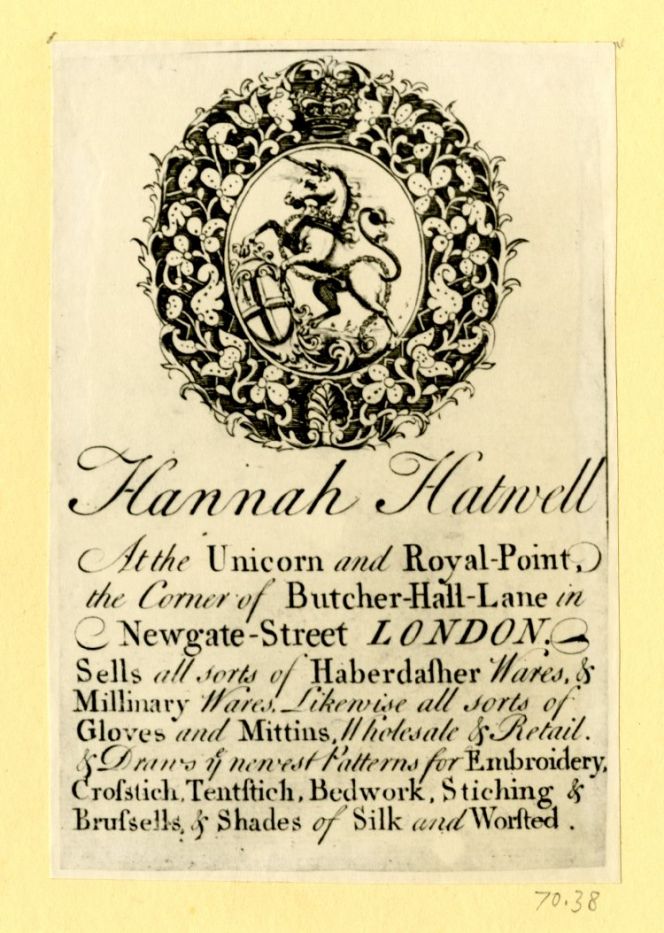
The majority of the haberdashers were men, but a smaller number of shops were run by women. This trade card illustrates one female shop owner – Hannah Hatwell at Newgate-Street in London – who described her assortment. Courtesy of: © Trustees of the British Museum, Trade cards, Banks 70.38. (Collection online).
Even if most haberdashers were men, they often aimed directly at a female clientele. The words chosen could be: ‘Great choice of patterns for Lady’s work, Embroidery, Brussels lace, Quilting, Cross & Tent stitch, Work materials for Needle work, Pattern for all sorts of Needlework, Shades of Worsted & Silk for the same’ or simply ‘Patterns for Lady’s Work’. The mourning trade was another branch sometimes included on the haberdashers’ trade cards – for example in the words ‘Also Funerals decently Perform’d’ or ‘Family Mourning’.
Services for families or professionals with connection to the colonies of the British Empire was another specialised haberdashery service in 18th century London. On a few preserved trade cards in the collection, one can read: ’Officers, Cadets, Gentlemen & Families going to the East or West Indies, supplied with Ready-made Linen’. (Hebbert – Haberdasher, Silk Mercer, Hosier & laceman, Millinery & Dress Warehouse, Strand London).
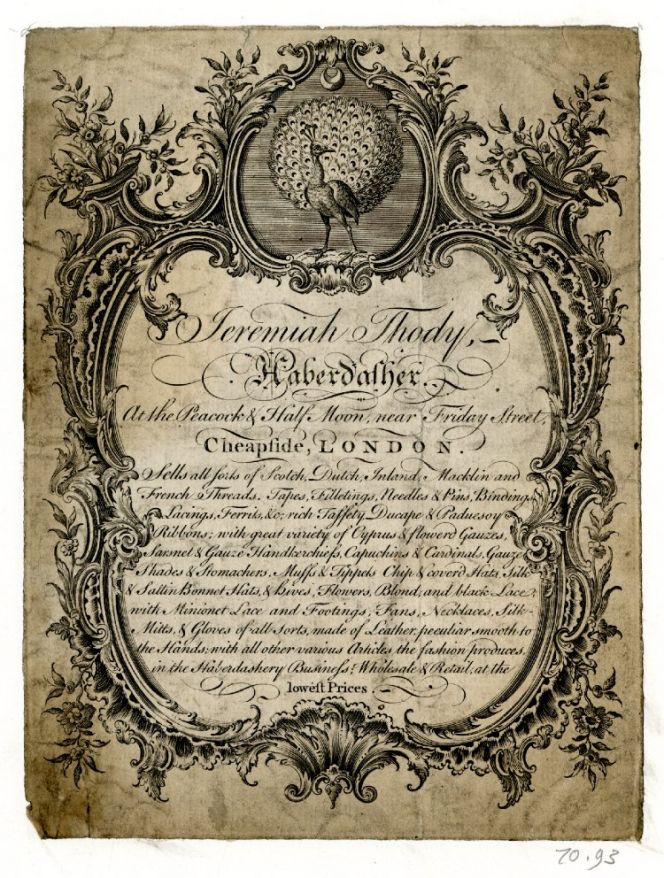
To demonstrate a beautiful design on one’s trade card together with as much information as possible was particularly important in the late 18th century. Here one representative example. Courtesy of: © Trustees of the British Museum, Trade cards, Banks 70.93. (Collection online).
The collection includes many examples of trade cards which list imported qualities and various goods described in great detail or mentioned with their place of origin. For example: Dutch and Manchester Tapes, Fine India Cottons, India Cotton Stockings, Bengal Muslins, Hollands Cambrics, Irish Linen, French Quilting, French Threads, French Cambrics, English & Dutch Toys, English Velvets, Manchester Goods, Norwich Crapes, India Knitting Cotton, Dresden Point Brussels, French & English Gauzes etc etc.
Another important feature was to point at the favourable prices, fashion trends and other services – explained with slogans to emphasise the qualities of the establishment:
- Lowest Prices/ Very Lowest Prices
- Very Reasonable Rates/ At Reasonable Rates
- After the Newest Fashion
- For Ready Money
- The very Best Goods at the Lowest Prices
- Newest & most Genteel taste
- Sells the Best Goods and lowest Terms – Country Orders executed
- Very Cheap for ready Money
- Proper Allowance for Ready Money
- The Lowest Price Affixed to each Article
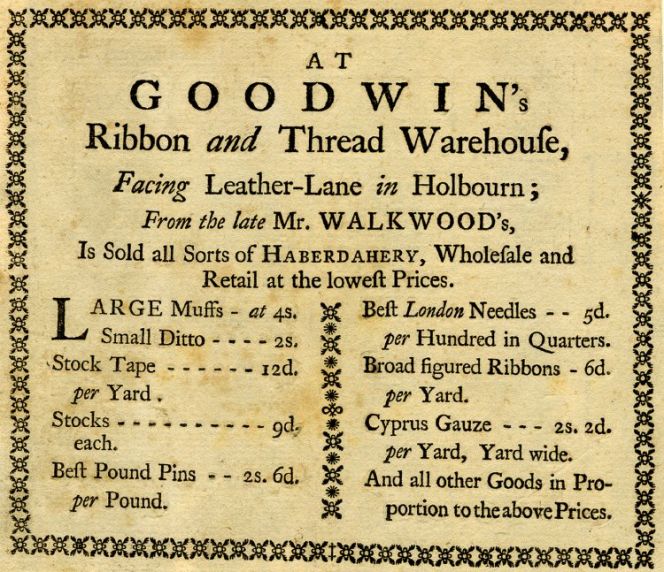
It was quite unusual to add printed “fixed prices” on a trade card, here is one exception from Mr. Walkwood who ‘Sold all Sorts of Haberdashery, Wholesale and Retail at the lowest Prices’. Courtesy of: © Trustees of the British Museum, Trade cards, Heal 70.65. (Collection online).
As shown from the haberdashery in the image above, it was not unusual to sell new as well as second-hand goods in the same shop. This was obviously a way to expand one's business; other financial transactions could be to accept long credits to known customers and cash payments. In other words, the haberdashers often seemed to adjust to the customer’s financial circumstances and culture of credit. For example, it could be stated: ‘The Public are served for present Cash upon such Terms as will insure their future favors’, ’Wholesale and Resale at Reasonable Rates’ or ‘Wholesale only’.
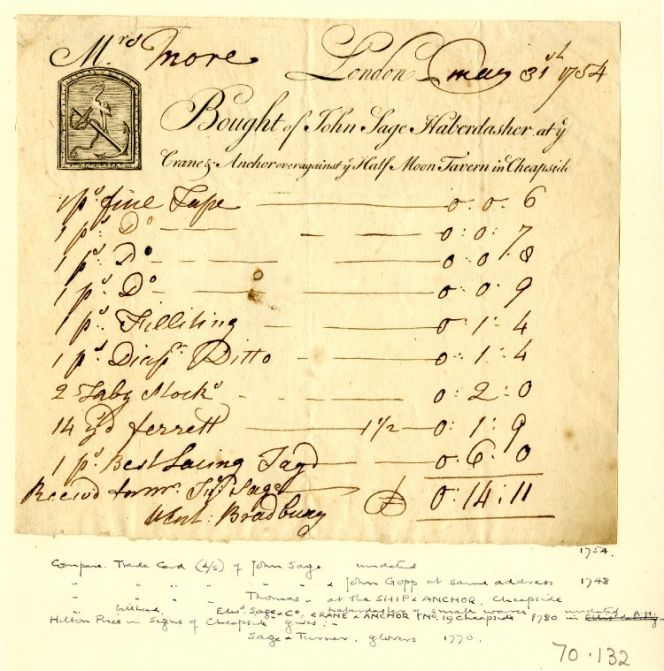
Here an example of an ordinary receipt/bill-head from a haberdasher – May 31st in 1754. As on this preserved document, most hand-written notes from haberdashers list quite modest sums. Courtesy of: © Trustees of the British Museum, Trade card, Heal 70.132. (Collection online).
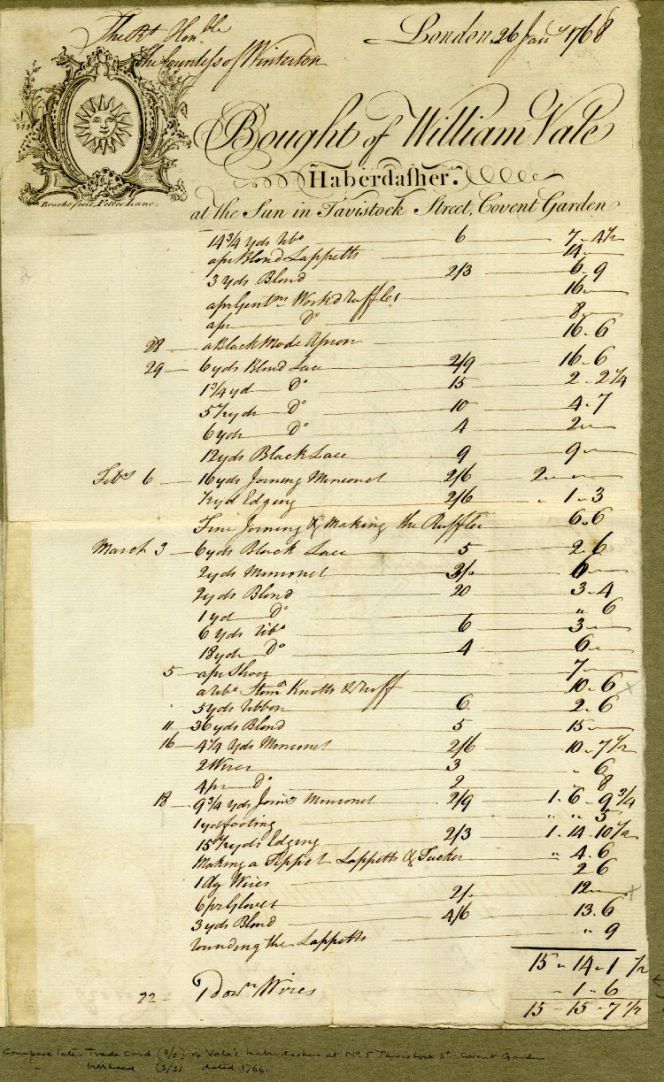 Rare exceptions to the modest sums also exist in this collection. As on this bill-head from haberdasher William Vale dating January 26th 1768, adding up to the considerable amount of more than £15. Courtesy of: © Trustees of the British Museum, Trade cards, Heal 70.173. (Collection online).
Rare exceptions to the modest sums also exist in this collection. As on this bill-head from haberdasher William Vale dating January 26th 1768, adding up to the considerable amount of more than £15. Courtesy of: © Trustees of the British Museum, Trade cards, Heal 70.173. (Collection online).



















